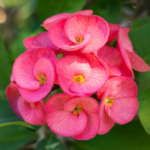Phalaenopsis orchids, affectionately known as moth orchids, are among the most popular and easy-to-care-for flowering plants. Their stunning, long-lasting blooms and graceful foliage enhance home decor and symbolize purity and strength. Whether you want to brighten your living room or create a serene workspace, these versatile orchids offer a blend of beauty and simplicity that transforms any environment. Dive into this guide to discover expert tips on care, propagation, and the fascinating history behind these timeless plants. Embark on your orchid journey today, gracefully.
Whether you’re a seasoned plant parent or a beginner looking to dive into the world of orchids, these beauties offer an elegant splash of nature that brightens any space.
What Are Phalaenopsis Orchids?

Phalaenopsis orchids belong to the Orchidaceae family and are celebrated for their long-lasting, vibrant blooms. With petals resembling the delicate wings of a moth, they have earned the nickname “moth orchids.” Their graceful curves, soothing colors, and easy-care nature make them a favorite among enthusiasts and casual admirers alike.
History and Origin
Native to Southeast Asia, the Philippines, and Australia, phalaenopsis orchids have a rich history that intertwines with local cultures and traditions. These orchids have been cultivated for centuries, and their popularity soared during the Victorian era when exotic plants became symbols of luxury and refinement. Today, thanks to advanced horticultural techniques, there is a vast variety of Phalaenopsis available to suit every taste.
Identification and Varieties
Recognizing the beauty of phalaenopsis orchids begins with understanding their unique features and the diverse varieties available.
Identification and Varieties
Phalaenopsis orchids are easily recognized by their unique physical features and wide range of color variations. Here’s a detailed look:
- Distinctive Features
- Broad, Fleshy Leaves: The large, succulent leaves serve as reservoirs for moisture, helping the plant thrive in varying conditions.
- Elegant Flower Spikes: These arching spikes often support multiple blooms simultaneously, giving the orchid a graceful appearance.
- Moth-Like Flowers: The flowers typically have a symmetrical structure with a prominent lip that resembles a moth’s wing, lending to their common name “moth orchid.”
- Varieties and Color Variations
- Classic White Varieties: Often admired for their pure, elegant look that suits any decor.
- Soft Pink and Purple Hues: These subtle shades exude sophistication and are popular in both modern and traditional settings.
- Bold and Vibrant Colors: Varieties in bright yellows, reds, and bi-color patterns add a dramatic focal point in any space.
- Hybrid Varieties: Through advanced cultivation techniques, many hybrids combine unique traits, offering improved bloom longevity and color intensity.
Growing Conditions for Phalaenopsis

Creating the perfect environment for your Phalaenopsis orchid is key to its long-term health and blooming success. Let’s dive into the ideal growing conditions that mimic their natural habitat.
Ideal Temperature and Humidity Levels
Phalaenopsis orchids thrive in warm, humid environments. Ideally, temperatures should range between 65°F to 80°F (18°C to 27°C) during the day and slightly cooler at night. These orchids enjoy an ambient humidity level of 50% to 70%, which can often be achieved with a small humidifier or by placing a water tray nearby. Ensuring these conditions helps prevent stress and encourages continuous blooming.
Light Requirements
Light is another crucial factor. Phalaenopsis orchids prefer bright, indirect sunlight. Direct sunlight can scorch their leaves, while too little light may reduce the frequency of blooms. Placing your orchid near a north or east-facing window is often ideal. If natural light is insufficient, consider using a grow light to supplement the brightness while keeping the light indirect and diffused.
Caring for Your Phalaenopsis Orchid
Proper care can transform your phalaenopsis from a mere decorative piece into a thriving, blossoming wonder. Let’s explore essential care tips.
Watering Practices
Overwatering is one of the most common mistakes made by orchid enthusiasts. Phalaenopsis orchids require a delicate balance—enough moisture to keep the roots happy but not so much that they risk rot. A good rule of thumb is to water your orchid once a week, allowing the water to drain out completely. During winter months or periods of lower light, you might reduce the frequency slightly. Always check the potting medium to ensure it’s moist but not soggy.
Fertilizing and Nutrition
While phalaenopsis orchids are not heavy feeders, they do appreciate a regular supply of nutrients to support their growth and blooms. Use a balanced orchid fertilizer—typically one formulated with a 20-20-20 ratio—and dilute it to half the recommended strength. Feeding your orchid every two to three weeks during the growing season, and less frequently during dormancy, will help maintain robust health.
Potting, Repotting, and Substrate
Phalaenopsis orchids are best grown in well-draining media such as bark mixes or sphagnum moss. When potting or repotting, choose containers with drainage holes to prevent water stagnation. It’s recommended to repot your orchid every one to two years to refresh the substrate and allow room for healthy root expansion. When repotting, gently remove old media from the roots and trim any dead or rotten sections.
Dealing with Common Issues
Even the most well-cared-for orchids can face challenges. Understanding common issues and their solutions can help you keep your phalaenopsis orchid thriving.
Pest Control
Pests such as mealybugs, spider mites, and aphids can sometimes invade your orchid. Look for signs of infestation like sticky residue or discolored leaves. Regularly inspect your plant, and if you spot pests, treat the affected areas with a gentle insecticidal soap or neem oil. Isolation of the infected plant is advisable to prevent the pests from spreading to other houseplants.
Disease Management
Fungal and bacterial infections can occur if the orchid is overwatered or kept in excessively humid conditions without adequate air circulation. Yellowing leaves or black spots can be indicators of disease. Improving air circulation, reducing watering frequency, and sometimes applying an appropriate fungicide can help manage these issues. Early detection is key, so keep a watchful eye on your plant’s overall health.
Propagation and Breeding Techniques
For those looking to expand their orchid collection or share the beauty of phalaenopsis with friends, propagation is a rewarding process.
Methods of Propagation
Phalaenopsis orchids can be propagated through several methods. One popular technique is division, where the orchid is split into smaller sections with each having its own root system. Another method is meristem propagation, which involves cultivating new plants from tissue cultures. Although the process can be a bit technical, many hobbyists find it a fulfilling challenge that results in multiple new blooms.
Tips for Successful Breeding
Successful propagation depends on timing and technique. Always use sterile tools and a clean working environment to prevent contamination. Ensure that each division or tissue culture piece has enough roots and healthy tissue. Patience is essential here; sometimes it can take several months to see significant growth in your newly propagated orchids.
Phalaenopsis in Home Decor and Symbolism

Phalaenopsis orchids are more than just a plant—they’re a statement piece in any living space. Their beauty and elegance extend beyond aesthetics.
Enhancing Interior Spaces with Orchids
Incorporating phalaenopsis orchids into your home decor can bring a touch of nature indoors. Their sleek lines and vibrant colors complement modern, minimalist, and even traditional decor styles. Place them on coffee tables, sideboards, or even hang them in creative displays to add a focal point that draws the eye and lifts the mood of any room.
Cultural Significance and Symbolic Meanings
Beyond their physical beauty, phalaenopsis orchids carry rich symbolic meanings. In many cultures, they are seen as symbols of beauty, luxury, and strength. They are often given as gifts to convey admiration and respect. In some parts of Asia, orchids represent refinement and are a sign of prosperity. Their long-lasting blooms are also seen as metaphors for endurance and timeless beauty, making them a popular choice for celebrations and special occasions.
Conclusion
Phalaenopsis orchids are truly a marvel of nature. Their stunning blooms, ease of care, and versatility in home decor make them a must-have for plant enthusiasts and casual decorators alike. By understanding their growing needs, identifying the right care practices, and learning how to tackle common issues, you can enjoy a flourishing orchid that brightens up your living space year after year.Embrace the journey of orchid care, experiment with different techniques, and let your green thumb flourish. And remember, every challenge is just an opportunity to learn something new about these fascinating plants. Happy growing!
Read to know more : Do Orchids Bloom in Warm Weather? Caring Tips
Frequently Asked Questions
Q1: Can I grow phalaenopsis orchids indoors year-round?
Absolutely! With the right light, temperature, and humidity, phalaenopsis orchids thrive indoors throughout the year.
Q2: How can I encourage my orchid to bloom more frequently?
Ensure your orchid is receiving bright, indirect light, and adjust watering and fertilizer routines according to seasonal changes. Sometimes, a slight drop in nighttime temperature can also trigger blooming.
Q3: What type of potting medium is best for phalaenopsis orchids?
A well-draining medium such as a mix of bark chips or sphagnum moss is ideal, as it prevents waterlogging while providing the necessary aeration for healthy root growth.
Q4: Is it normal for phalaenopsis orchids to have a resting period between blooms?
Yes, many phalaenopsis orchids go through a dormancy or resting period. During this time, they might not bloom, but with proper care, they will eventually produce new flower spikes.
Q5: What are some common mistakes to avoid when caring for a phalaenopsis orchid?
Overwatering, placing the orchid in direct sunlight, and neglecting regular repotting can harm your orchid. Always monitor environmental conditions and adjust your care routine accordingly.







